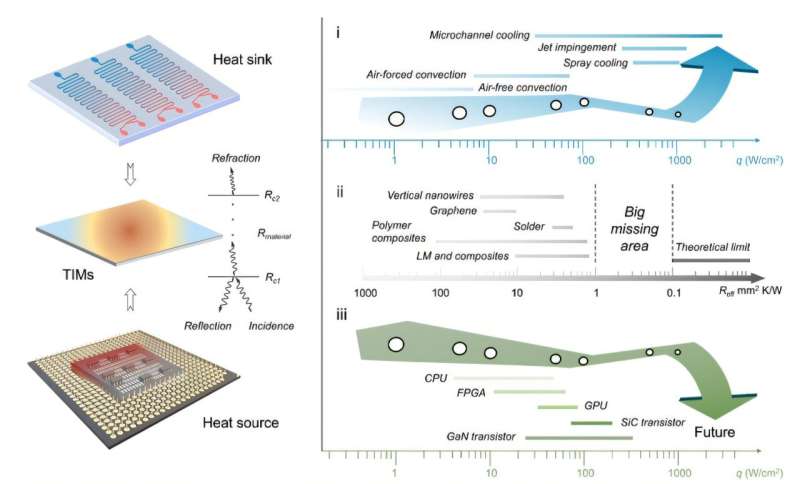
October 22, 2024 by University of Texas at Austin
Collected at: https://techxplore.com/news/2024-10-thermal-interface-material-cool-energy.html
A new cooling technology could change how heat is managed in electronic devices—from tiny semiconductors to massive data centers.
A team led by scientists and engineers at The University of Texas at Austin have created a new “thermal interface material” that could organically remove heat from high-powered electronic devices, reducing or even eliminating the need for extensive cooling. The new material, made from a mix of liquid metal and aluminum nitride, is much better at conducting heat than current commercial materials, making it optimal for cooling.
The research is published in the journal Nature Nanotechnology.
“The power consumption of cooling infrastructure for energy-intensive data centers and other large electronic systems is skyrocketing,” said Guihua Yu, professor in the Cockrell School of Engineering’s Walker Department of Mechanical Engineering and Texas Materials Institute. “That trend isn’t dissipating anytime soon, so it’s critical to develop new ways, like the material we’ve created, for efficient and sustainable cooling of devices operating at kilowatt levels and even higher power.”
Cooling accounts for about 40% of data center energy usage, or 8 terawatt-hours annually. The researchers estimate their technology could shave 13% off that cooling requirement—or 5% off overall data center energy usage—a significant savings if applied across the industry. The heat dissipation capabilities also allow for significant growth in processing power.
The new discovery is part of a larger effort to realize the potential of thermal interface materials. These materials are designed to dissipate heat generated by electronic devices, reducing the need to cool those devices.
However, a gap exists between how much cooling these materials should theoretically be able to achieve and what they’ve done in real-world tests.

The new materials in this project were able to bridge that gap. This material can remove 2,760 watts of heat from a small area of 16 square centimeters. It can cut the energy needed for the cooling pump, a significant piece of the overall electronics cooling puzzle, by 65%.
“This breakthrough brings us closer to achieving the ideal performance predicted by theory, enabling more sustainable cooling solutions for high-power electronics,” said Kai Wu, lead author in Yu’s lab. “Our material can enable sustainable cooling in energy-intensive applications, from data centers to aerospace, paving the way for more efficient and eco-friendly technologies.”
The explosive growth of artificial intelligence, along with the continued proliferation of technology, is expected to drive significant increases in data center demand. That means more energy is needed to power and cool these centers.
Earlier this year, Goldman Sachs estimated that data center power demand will grow 160% by 2030. It is estimated that AI alone will increase data center power consumption by 200 terawatt-hours per year between 2023 and 2030.
The researchers created the new cooling material using a special process called mechanochemistry. This process helps the liquid metal and aluminum nitride mix in a very controlled way to create gradient interfaces, making it easier for heat to move through them.
The researchers have tested their materials on small lab-scale devices. The team is in the process of scaling up material synthesis and preparing samples to test with partners in data centers.
The research team includes Chuxen Lei of UT’s Materials Science and Engineering program and collaborators Zhengli Dou, Shibo Deng, Die Wu, Bin Zhang, Runlai Li, Yongzheng Zhang and Quiang Fu of Sichuan University, and Haobo Yang of Huazhong University of Science and Technology.
More information: Kai Wu et al, Mechanochemistry-mediated colloidal liquid metals for electronic device cooling at kilowatt levels, Nature Nanotechnology (2024). DOI: 10.1038/s41565-024-01793-0
Journal information: Nature Nanotechnology

Leave a Reply